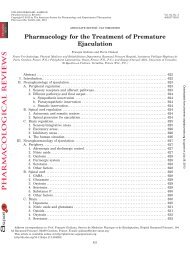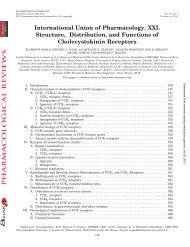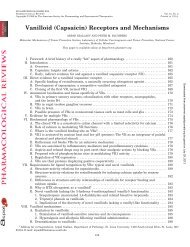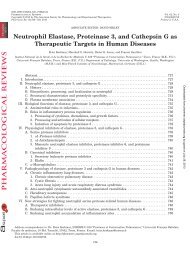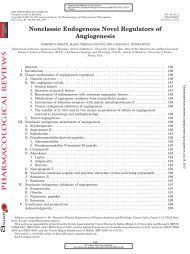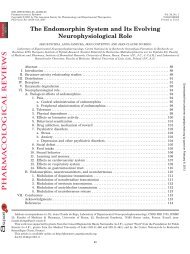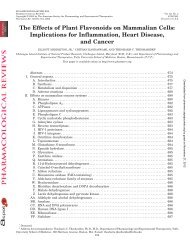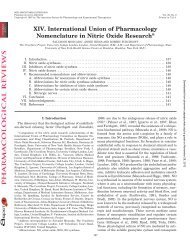Opioids, Reward and Addiction: An Encounter of Biology ...
Opioids, Reward and Addiction: An Encounter of Biology ...
Opioids, Reward and Addiction: An Encounter of Biology ...
Create successful ePaper yourself
Turn your PDF publications into a flip-book with our unique Google optimized e-Paper software.
5. Predisposing Variables. a. PRENATAL EXPOSURE.<br />
Preexposure to opioids during gestation has a significant<br />
effect on the development <strong>of</strong> drug self-administration in<br />
rats. Chronic treatment <strong>of</strong> female Sprague-Dawley rats<br />
with methadone throughout gestation <strong>and</strong> lactation resulted<br />
in an increase in oral self-administration <strong>of</strong> morphine<br />
by their 11- to 12-week-old <strong>of</strong>fspring (Hovious<br />
<strong>and</strong> Peters, 1985). Surprisingly, methadone selfadministration<br />
in the methadone <strong>of</strong>fspring was not different<br />
from controls. Ramsey et al. (1993) showed that<br />
10- to 12-week-old male Wistar rats born from females<br />
treated with morphine during gestation exhibited<br />
higher heroin intake during initiation <strong>of</strong> self-administration<br />
than their prenatal saline-treated controls. Interestingly,<br />
in similarly treated rats initiation <strong>of</strong> cocaine<br />
self-administration was also higher than in the controls.<br />
These results suggest that prenatal exposure to opioids<br />
may facilitate the development <strong>of</strong> drug self-administration,<br />
hence, being an important risk factor in the etiology<br />
<strong>of</strong> drug addiction.<br />
b. ENVIRONMENTAL FACTORS. Specific environmental<br />
factors play a role in the individual differences in drug<br />
self-administration. For instance, the effect <strong>of</strong> manipulation<br />
<strong>of</strong> the social housing conditions on oral morphine<br />
self-administration in rats has been examined <strong>and</strong> it<br />
was found that isolation, as compared to group housing,<br />
enhanced this behavior (Alex<strong>and</strong>er et al., 1978).<br />
<strong>An</strong>other environmental factor which might be <strong>of</strong> significance<br />
to drug intake is stress. Nonphysical (emotional)<br />
stress as opposed to physical stress (inescapable shocks)<br />
<strong>and</strong> to control conditions enhanced the initiation <strong>of</strong> i.v.<br />
self-administration <strong>of</strong> morphine in two inbred strains <strong>of</strong><br />
mice (Kuzmin et al., 1996c). In these experiments, the<br />
physical stress consisted <strong>of</strong> a session <strong>of</strong> 10 mild unpredictable<br />
<strong>and</strong> inescapable footshocks, <strong>and</strong> emotional stress<br />
meant being forced to witness this treatment. Under similar<br />
conditions, it has been shown that emotional stress,<br />
but not physical stress, enhanced the initiation <strong>of</strong> cocaine<br />
intake in drug-naive rats (Ramsey <strong>and</strong> Van Ree, 1993).<br />
Other experiments have shown that immobilization stress<br />
<strong>and</strong> particularly predictable, repeated footshock stress facilitated<br />
oral self-administration <strong>of</strong> morphine <strong>and</strong> fentanyl<br />
<strong>and</strong> i.v. self-administration <strong>of</strong> heroin in rats (Shaham et<br />
al., 1992; Shaham <strong>and</strong> Stewart, 1994; Klein et al., 1997).<br />
Together, it can be concluded that stress, <strong>and</strong> in particular<br />
emotional distress, might increase the development <strong>of</strong> opioid<br />
self-administration.<br />
The nutritional state <strong>of</strong> a subject can also interfere<br />
with the reinforcing effects <strong>of</strong> the drug. It has been<br />
demonstrated that food restriction increased drugreinforced<br />
behavior <strong>and</strong> drug intake. This deprivationinduced<br />
facilitation was found with most classes <strong>of</strong><br />
drugs, including opioids, during maintenance as well as<br />
during initiation <strong>of</strong> drug self-administration (Takahashi<br />
et al., 1978; Caroll et al., 1981; Oei, 1983; De Vry et al.,<br />
1989a). It has been hypothesised that body weight reduction,<br />
<strong>and</strong> not food deprivation per se, gives rise to<br />
OPIOIDS, REWARD AND ADDICTION 355<br />
differential sensitivity to the reinforcing properties <strong>of</strong><br />
the drugs (Oei, 1983; Carroll <strong>and</strong> Meisch, 1984). The<br />
increased drug self-administration may probably result<br />
from an interaction between weight loss-induced general<br />
activity <strong>and</strong> weight loss-induced sensitization to the<br />
reinforcing effects <strong>of</strong> the drug (De Vry et al., 1989a). In<br />
addition, it has been shown that the presence <strong>of</strong> a fixed<br />
time, noncontingent food delivery schedule facilitated<br />
the rate <strong>of</strong> acquisition <strong>of</strong> heroin self-administration (Oei<br />
et al., 1980; Wallace <strong>and</strong> Van Ree, 1981).<br />
c. GENETIC FACTORS. The possible role <strong>of</strong> genetic factors<br />
in drug dependence has received increasing attention<br />
over the last years. Sophisticated animal models<br />
have been developed to investigate the contribution <strong>of</strong><br />
genetic factors in the individual sensitivity for the reinforcing<br />
effects <strong>of</strong> drugs <strong>of</strong> abuse. These models range<br />
from selective breeding <strong>of</strong> animals with characteristic<br />
responding for drugs to the construction <strong>of</strong> recombinant<br />
inbred strains (Crabbe <strong>and</strong> Belknap, 1992). Over the<br />
years much effort has been put in the selection <strong>and</strong><br />
breeding <strong>of</strong> genetically different strains <strong>of</strong> animals responding<br />
for alcohol (George, 1993). Fewer attempts<br />
have been made to genetically select animals on the<br />
basis <strong>of</strong> their sensitivity for other drugs <strong>of</strong> abuse, although<br />
several groups have reported on genetic differences<br />
in opioid intake. Differences in intake <strong>of</strong> the pure<br />
opioid agonists morphine or etonitazine have been found<br />
in different rat stocks (Carroll et al., 1986b), selectively<br />
bred rat strains (Satinder, 1977), inbred rats (Suzuki et<br />
al., 1992a; Ambrosio et al., 1995), <strong>and</strong> inbred mice<br />
(Horowitz et al., 1977; Kuzmin et al., 1996c). As an<br />
example, initiation <strong>of</strong> i.v. morphine self-administration<br />
was tested in two genetically inbred strains <strong>of</strong> mice<br />
(C57BL/6 <strong>and</strong> DBA/2) (Kuzmin et al., 1996c). It was<br />
found that whereas DBA/2 readily initiated morphine<br />
self-administration according to an inverted U-shaped<br />
dose-response curve, the C57BL/6 mice did not initiate<br />
morphine intake. However, exposure to acute emotional<br />
stress induced by forcing mice to witness another mouse<br />
receiving footshocks caused the C57BL/6 mice to start<br />
self-administering morphine. Furthermore, as with psychostimulants,<br />
a relationship has been proposed between<br />
high locomotor response to a novel environment<br />
<strong>and</strong> a high morphine intake during initiation <strong>of</strong> selfadministration<br />
(Ambrosio et al., 1995; Piazza <strong>and</strong> Le<br />
Moal, 1996). Rats with a high preference for saccharin<br />
showed more morphine self-administration than rats<br />
with a low preference for saccharin (Gosnell et al., 1995).<br />
The primary importance <strong>of</strong> these kind <strong>of</strong> studies is that<br />
they indicate that genotype can be a specific determinant<br />
<strong>of</strong> drug-taking behavior. Moreover, the study <strong>of</strong><br />
Kuzmin et al. (1996c) reveals that genetic <strong>and</strong> environmental<br />
factors interact in the sensitivity for opioid reinforcement.<br />
6. Treatment Interference Studies. The drug selfadministration<br />
model has been used to evaluate possible<br />
new pharmacotherapies for the treatment <strong>of</strong> opioid addic-



